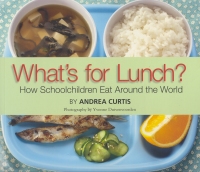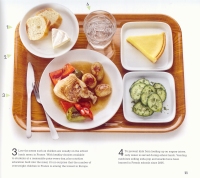| ________________
CM . . . . Volume XIX Number 3 . . . . September 21, 2012
excerpt:
"All children need a healthy lunch to be able to learn and grow." Following this assertion in the Introduction, author Andrea Curtis presents details about school lunch programs around the world – most are government sponsored with the exception of Canada which does not have a national school meal program. Some of these programs may provide the only lifeline for children who have nothing to eat at home, and they all offer insight into culture and history. And it isn't always a fact that such school lunches offer healthy meals. Along with the accounts from 13 countries are encouraging stories of projects undertaken in many cases by students to improve the quality of their food and to reduce its environmental impact.
The global food industry influences meal choices, and is responsible for many of the changes to traditional diets worldwide. That's the impetus for the stories about students pushing for change -- American students advocating for more fresh fruits and vegetables; Italian children demanding locally produced food; and the development of floating school gardens in Bangladesh that will lessen the impact of seasonal flooding on food supplies. In Toronto, a workshop allows kids to role-play as individuals at different levels of society and to discuss how to effect positive changes to reduce inequalities with respect to healthy food availability. These stories will be excellent discussion starters, involving the reader in thinking about ways to better meet the challenges of food issues. The "Message to Parents, Teachers and Students", found in the final pages, will further encourage this kind of discussion, with particular focus on themes such as the fast-food culture, evolution of traditional diets, how technology has impacted food production and distribution, and the consequences of power shifts toward developed nations. The page, "Reclaiming School Lunch" offers suggestions for ways kids can get involved with promoting healthy eating. A Glossary completes the book. What's for Lunch? may not be a book kids pick up and read on their own, although the bright cover image and title question will arouse curiosity. The vocabulary and fairly dense visual presentation of the text are best suited to ages 10 and up. It is definitely a valuable, well-researched resource for kids and adults to share. The information is eye-opening, and ideas will challenge assumptions. The term "food justice" is thought-provoking. This book's strength lies in its potential for enhancing understanding of the critical nature of food concerns. Highly Recommended. Gillian Richardson is a freelance writer living in BC.
To comment
on this title or this review, send mail to cm@umanitoba.ca.
Copyright © the Manitoba Library Association. Reproduction for personal
use is permitted only if this copyright notice is maintained. Any
other reproduction is prohibited without permission.
NEXT REVIEW |
TABLE OF CONTENTS FOR THIS ISSUE
- September 21, 2012.
AUTHORS |
TITLES |
MEDIA REVIEWS |
PROFILES |
BACK ISSUES |
SEARCH |
CMARCHIVE |
HOME |

 Each lunchroom description explains what's on the menu, how the lunches are prepared, served and eaten, plus what input students have in the process. The meal is pictured as it is served (on everything from ceramic plates and silverware to sheets of paper), with interesting facts added about each item and comments about the nutritional worth. Young readers will find the types of foods eaten in each area especially intriguing, and they will be able to see how big a role culture and tradition play. For instance, in the island nation of Japan, fish is a predominant meal item. Beans are the staple in Mexico, while Russian children eat borsch made with beets. In Peru, guinea pigs are raised for food, but Chinese children usually find rice and vegetables on the tray.
Each lunchroom description explains what's on the menu, how the lunches are prepared, served and eaten, plus what input students have in the process. The meal is pictured as it is served (on everything from ceramic plates and silverware to sheets of paper), with interesting facts added about each item and comments about the nutritional worth. Young readers will find the types of foods eaten in each area especially intriguing, and they will be able to see how big a role culture and tradition play. For instance, in the island nation of Japan, fish is a predominant meal item. Beans are the staple in Mexico, while Russian children eat borsch made with beets. In Peru, guinea pigs are raised for food, but Chinese children usually find rice and vegetables on the tray.